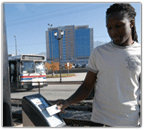Set to launch in June is a student geared, eco-friendly, electronic coupon campaign designed to save student consumers money, while at the same time generate more business for local establishments, reports The Gainesville Sun.
Developed by owners of Mint Magazine and American Values Magazine, ECouponNation is a discount program that enables students to access real-time discounts via their mobile phone.
Business owners can update events, activities, giveaways and discounts, and the Web site will then relay the information for students to receive instant access to.
ECouponNation said it plans to keep students’ attention by offering $20,000 worth of free products, food giveaways and entertainment each year.
Officials stated that ECouponNation is still in its beta phase but is looking to expand both electronically and demographically, adding that if the Gainesville market is a success, ECouponNation will go on to Tallahassee.
To read more click here.
 The multi-function, multi-app smart card may not be such a mythical beast
The multi-function, multi-app smart card may not be such a mythical beast
Multi-function cards on college campuses aren’t new. Student IDs have paid for meals, accessed residence halls and checked out library books for decades. But adding applications that can be used outside of the university has been more difficult. Off-campus merchant programs are common but beyond that the campus card remains an on-campus tool.
A number of universities have expressed interest, largely due to student demand, in using the card off-campus in the local transit agency’s contactless fare collection system. While campuses have offered students deals on public transportation passes in the past, this has typically involved a separate card or a homegrown solution with a campus card reader on the transit vehicles.
Integration with the existing contactless system is a far more seamless solution, but it has proven to be an elusive goal. The problem is that transit agencies frequently use proprietary systems and specific contactless card types that don’t readily translate to other uses. In other words, if a campus issues a contactless card that meets the transit specs it may not be usable for on campus needs such as access control.
Obviously, the ideal scenario is a standard contactless technology that serves the campus card needs and also supports the transit application. This has not been the case.
In most cities with contactless fare collection systems, a local university would need to buy a specific card from the transit system’s vendor. The campus would then issue this card in its normal manner and use the magnetic stripe for school needs. The transit application could either be pre-loaded on the contactless chip or the student could take it to a specific location to turn-on the functionality.
The process is cumbersome, expensive and virtually eliminates the campus from utilizing contactless technology for its own needs.
New transit systems open door for campus cooperation
The challenges that have kept campus cards and transit cards largely separate are beginning to ease. Fare collection systems are evolving and at the same time campus card programs are recognizing the benefits of contactless technology. The time may be right for cooperation as exemplified by recent projects in Utah and Washington D.C.
The Utah Transit Agency (UTA) approached its fare collection system differently than others in the U.S. It opted to deploy a more open system that accepts multiple card types including its own fare collection cards and bank-issued contactless credit and debit cards.
The UTA system as deployed by ERG Group, now owned by Cubic, and MetraTech, a Boston-based billing and settlement provider. Utah was ERG’s first foray into this type of public transit payment mechanism.
“It’s the first and only one we believe that’s been fully deployed,” says Michael Cook, ERG’s vice president of business development for the Americas. “There are other systems out there that use a credit card, but it’s really a transit application embedded in the card that gives the appearance that someone is using a credit card. We view Utah as our future. It’s similar to what they’re doing in New York, but on the subway it’s a flat fare structure. Here we can accommodate all types of fares.”
Westminster College in Salt Lake City and Utah Valley University in Orem have started using contactless cards for student IDs and enabling the same card to be used as a transit pass. The two schools, however, took different paths to get there.
Utah Valley was already using a multi-technology student ID card, including a Mifare chip and magnetic stripe, says Dawn Bridges, manager of the Campus Connection ID Station at the university. The campus has a Blackboard transaction system and uses Lenel to manage physical access control. The contactless chip is also starting to be used for a time clock system.
Utah Valley and the UTA had worked together previously and when the school found out its ID card could work with the transit system administrators decided to combine them, Bridges says. Students pay $20 a month for the pass and the information stored on the chip is then sent to the UTA. That way when the student taps the card on the reader it’s read as valid. The two are also working on a system that would enable real-time connectivity.
Westminster College took a different approach when combining its student ID and transit pass. The school had not been using a contactless card but decided to make the switch after discussions with the UTA, says Kerry Case, director of the environmental center at Westminster. “It’s nicer to have only to carry around one card instead of two,” she says. “With the old passed you had to show your student ID card with the transit pass if the transit police asked.”
The school is now buying blank card stock from the UTA to use as its student ID, Case says. Since the UTA buys card stock in bulk it’s cheaper than Westminster buying it on its own. The card also has a magnetic stripe that is used for food service, access to the gym and other applications. Westminster has an in-house system for managing the campus card program for its 2,500 students.
The primary purpose of the contactless portion of the card is for the transit pass, says Collin Bunker, director of information services at Westminster. When the card is issued the number on the chip is sent to the UTA and updates are sent on a weekly basis. Students don’t have to pay for the pass as long as they use the system a certain number of times a month.
But with contactless cards starting to be issued throughout campus the college is rolling out additional functionality, Bunker says. Westminster is putting contactless physical access control readers in its new science building to enable student access to the labs after hours. He says the school is considering expanding the contactless physical access control system over time to other buildings and is also exploring its use for meal plans as well.
American University in Washington is conducting a pilot combining its student IDs with the Washington Metropolitan Area Transit Authority, according to a university spokesperson.
A small number of American University student IDs with the transit agency’s contactless SmarTrip functionality are being tested by selected members of the campus community. If all goes well and the test is successful, then the entire American University community may soon be offered the option to integrate their student ID with SmarTrip access.
Whereas the UTA used the ISO 14443 contactless smart card standard for its cards, SmarTrip uses a proprietary technology that can only be purchased from the system vendor. This would also make it difficult to use the card for anything other than the transit program.
For several years, however, rumor that the Washington D.C. transit program would migrate from the proprietary card to a more standard card type has circulated. If this was the case, American University could one day issue the combined card and open up the use of the contactless chip for on-campus applications.
A dual-use future?
As contactless smart cards become more popular on campus its possible there may be more integration like those in Utah and Washington D.C. For this to happen on a large scale, however, changes are still required.
Transportation officials will have to decide if using a proprietary, closed-loop system is better than a more inclusive, open fare collection system. Unless this move to card types that readily support campus applications occurs, campus card administrators will need to weigh the relative importance of the transit application compared to the other on-campus applications of contactless technology.
The CBORD Group, provider of campus card and integrated security solutions to colleges and universities, unveiled the latest release of its CS Gold campus card solution.
The new release (Version 6) looks to make it easier for colleges to manage campus card operations ranging from dining to access, and from alarm management to on- and off-campus purchasing.
The new CS Gold 6 brings improved OS navigation with support for Oracle 11g, Windows 2008, and 64-bit technology, and IT security enhancements to reduce system compromises.
CS Gold is a modular campus card and security management solution with a range of functionality that includes meal plans, stored value and credit, access control, alarm management, entitlements tracking, card production, online functionality, integrated video, targeted notifications.
 The recent years have not been easy for financial institutions. Bad loans, stock price declines and scandals have been almost daily headlines. Yet despite the tough environment, the number of campus card program and bank partnerships continued to grow in 2009.
The recent years have not been easy for financial institutions. Bad loans, stock price declines and scandals have been almost daily headlines. Yet despite the tough environment, the number of campus card program and bank partnerships continued to grow in 2009.
Each year the editorial team at CR80News surveys financial institutions that actively work with higher education institutions to offer banking services as a part of the campus card program. While our respondents and other financial institutions offer a host of diverse services to campuses and their students, only relationships that integrate the official university-issued ID card as a banking tool are considered for the survey.
Since the inaugural CR80News survey was conducted in 2003, the number of partnerships has grown nearly threefold. A small number of financial institutions have come and gone from the survey but the core group of providers has remained consistent. From the beginning, five institutions have been active providers of services via campus cards. PNC Bank, TCF Bank, US Bank, Wachovia and Wells Fargo have consistently accounted for more than 80% of the partnerships identified via the survey.
| Bank | ‘08 total | ‘09 total | % change |
|---|---|---|---|
| U.S. Bank | 37 | 46 | 24% |
| Wells Fargo | 41 | 42 | 2% |
| PNC Bank | 10 | 15 | 50% |
| TCF Bank | 11 | 8 | -27% |
| Commerce | 4 | 4 | 0% |
| Heartland/CNB | 9 | 17 | 89% |
| SunTrust | 2 | 2 | 0% |
| Total | 114 | 134 | 18% |
This year the acquisition of Wachovia by Wells Fargo was completed and thus for the first time the two providers are combined in our tabulations.
In years past we have identified trends and measured growth by evaluating the entire list of submissions. This year we took a different approach and analyzed the numbers for this core group of consistent providers. In this way we are better able to examine the results through time.
 Evaluating results for the core group of active bank partners
Evaluating results for the core group of active bank partners
Examining the data for this core group of five providers we can accurately track trends in the market.
In seven years of data, there has been an average annual growth rate of 15.4% for this core group. 2009 held consistent with an increase of 13.2%. This year’s addition of 13 relationships outpaces the 10-relationship average for the seven-year period for the group.
The big winners for 2009 were U.S. Bank and PNC Bank. Both experienced double-digit growth rates as U.S. Bank added 9 campuses for a 24% increase from the prior year and PNC Bank added 5 clients for an impressive 50% rate of growth.
Only one provider, TCF Bank, experienced a decline in banking partnerships during 2009. The Minnesota-based institution dropped from 11 partnerships to 8 as three clients transitioned to other providers. Interesting, each of three selected a different financial institution from the core group to provide the new service. Minnesota State University Mankato is now working with Wells Fargo, DePaul University with PNC Bank, and Milwaukee Area Technical College selected U.S. Bank.
Results from the total pool of respondents
When we view the entire group of respondents–the core group plus Central National Bank & Trust Company (CNB)/Heartland Payment Systems, Commerce Bank and SunTrust–this year they collectively account for 135 relationships. This is an 18% increase from last year and an aggregate gain of 21.
SunTrust and Commerce Bank have maintained their clients, two and four respectively, for many years with no additions. Last year Heartland Payment Systems joined the list by offering campus card banking services by partnering with CNB. The pair almost doubled the number of relationships jumping from nine to 17 in 2009.
Footprints changes could lead to greater competition
As you will read in another article in this issue, Florida State University is in the process of selecting a new banking partner. It is an interesting example of how a banks footprint impacts the opportunities for campuses seeking providers.
Because the Florida State program has been very successful over the years, one could safely assume that it would be of interest to any financial institutions actively seeking campus card business. Maybe, but many are unable to do so because only banks that already have branches in that state will be able to compete for the business.
Thus it is likely that the incumbent provider SunTrust and Wells Fargo will be the only two that have submitted proposals. Prior to the acquisition of Wachovia, Wells Fargo would not have been able to do so as they had no presence in Florida. Similarly, U.S. Bank, PNC and TCF have no footprint so they could not apply.
Today the combined Wells Fargo and Wachovia footprint crosses 39 states. U.S. Bank can serve campus card clients in 24 states. TCF and PNC each cover eight states while Commerce Bank serves five states.
The relevance, of course, is that if a campus is looking for a bank partner they need to find an institution that can work in the state.
PNC Bank (15)
Allegheny College, PA
Arcadia University, PA
Carnegie Mellon University, PA
DePaul University, IL
Duquesne University, PA
Edinboro University of Pennsylvania, PA
Indiana University of Pennsylvania, PA
Marymount University, VA
Mercyhurst College, PA
Mount St. Mary’s University, MD
Penn State University–18 campuses, PA
St. Joseph’s University, PA
University of Delaware, DE
University of Pennsylvania, PA
University of Pittsburgh, PA
TCF Bank (8)
Eastern Michigan University, MI
Northern Illinois University, IL
Northern Michigan University, MI
St. Cloud State University, MN
St. Xavier University, IL
University of Illinois, IL
University of Michigan, MI
University of Minnesota, MN
Heartland/CNB (17)
Clearwater Christian College, FL
Colorado Christian University, CO
Concordia University of Wisconsin, WI
Harrisburg University, PA
Hillsborough Community College, FL
Florida Coastal School of Law, FL
John Carroll University, OH
Lebanon Valley College, PA
Mount Holyoke College, MA
North Central Missouri College, MO
Palm Beach Atlantic University, FL
Pittsburgh Technical Institute, PA
Reinhardt College, GA
Slippery Rock University, PA
Tompkins Cortland Community College, NY
University of Massachusetts Lowell, MA
Waukesha County Technical College, WI
SunTrust (2)
Florida State University, FL
University of Central Florida, FL
Commerce (4)
Fort Hays State University, KS
Pittsburg State University, KS
The University of Kansas, KS
Wichita State University, KS
Wells Fargo (42)
Baylor University TX
California State University–East Bay, CA
California State University–Los Angeles, CA
California State University–Sacramento, CA
California State University–San Francisco, CA
California State University–Stanislaus, CA
Clark Atlanta University, GA
El Paso Community College, TX
Elon University, NC
Fayetteville State University, NC
Florida A&M University, FL
Front Range Community College, CO
Georgia Perimeter College, GA
Guilford College, NC
Mercer University, GA
Mesa State College, CO
Midwestern State University, TX
Minnesota State University–Mankato, MN
New Mexico State University, NM
NC State University, NC
North Carolina A&T State University, NC
North Carolina Central University, NC
Riverside Community College District, CA
Texas A&M University–College Station, TX
Texas A&M University–Corpus Christie, TX
Texas State University–San Marcos, TX
University of Arizona, AZ
University of Florida, FL
University of Nebraska–Kearney, NE
University of Nebraska–Lincoln, NE
University of Nevada–Las Vegas, NV
University of Nevada–Reno, NV
University of N.C.–Chapel Hill, NC
University of N.C.–Greensboro, NC
University of North Texas, TX
University of Northern Colorado, CO
University of Texas–Arlington, TX
University of Texas–Brownsville, TX
University of Texas–Dallas, TX
University of Texas–El Paso, TX
Villanova University, VA
Virginia Commonwealth University, TX
U.S. Bank (46)
Austin Peay State University, TN
Bellevue College, WA
Benedictine University, IL
California State University–Fullerton, CA
Capital University, OH
Carroll University, WI
Case Western Reserve University, OH
Central Washington Reserve University, WA
Chicago State University, IL
College of Mt. St. Joseph, OH
Creighton University, NE
Drury University, MO
Gonzaga University, WA
Henderson State University, AR
Iowa State University, IA
John Carroll University, OH
Johnson County Community College, KS
Kirkwood Community College, IA
Metopolitan State College of Denver, CO
Milwaukee Area Technical College, WI
Minnesota State University–Moorhead, MN
Missouri Baptist University, MO
Missouri Western State University, MO
Morehead State University, KY
North Dakota State University, ND
Northern Kentucky University, KY
Northwest Missouri State University, MO
Northwestern University, WI
Ouachita Baptist University, AR
Pacific University, OR
Saint Louis University, MO
San Diego State University, CA
Southwestern College, CA
St. Cloud Technical College, MN
Thomas More College, KY
Truman State University, MO
University of California Davis, CA
University of Central Missouri, MO
University of San Diego, CA
University of Wisconsin–Eau Claire, WI
University of Wisconsin–Oshkosh, WI
University of Wisconsin–Stevens Point, WI
Washington State University, WA
Waukesha County Technical College, WI
Wisconsin Lutheran College, WI
Xavier University, OH
Liberty University, out of Lynchburg, Va., is keeping students and faculty safe while surfing the Web thanks to digital certificates developed together with Verizon Business.
The Christian university, along with Verizon, came up with a digital certificate that could be used to secure personal student information, financial records and other university data.
Based on Secure Socket Layer technology, the certificate service protects online users by establishing a secure exchange between a Web page and the end user, and then encrypting the data passing between them.
This is especially critical when said information is credit card data, Social Security numbers and other personal information.
 Programs drawing interest from national retailers
Programs drawing interest from national retailers
Dominican College in Orangeburg, N.Y. has 2,050 students with about 700 living on campus. The school’s campus ID is used for access to meal plans, physical areas, vending, photocopying, laundry and an off-campus program that has been in place for seven years.
The institution launched the off-campus program to give students more options to choose from and make it easier for them to pay for goods and services, says Michael Quinn, director of One Card service at Dominican. The program now includes 27 retailers, from pizzerias and Chinese food to CVS and oil changes.
Where Dominican sought to increase student service, in a down economy other universities are deploying off-campus programs to try and bring in revenue. Whatever the reason, these programs are drawing interest from national brands, such as CVS, whereas previously they had appealed largely to local businesses.
Dominican may have been ahead of the curve with its program, but a 2008 survey from the National Association of Campus Card Users found universities considering off-campus programs at a growing rate. The survey included 48 campuses, half of which were considering off-campus programs and 20 of which already had programs in place. Of those 20 universities, 16 had programs running for more than five years.
Off-campus programs can be a source of extra income for schools. At Dominican retailers pay 10% of each purchases to the college. This is then split with Heartland Payment Systems, Dominican’s campus card provider, explains Quinn.
For retailers it may seem like a hefty price to pay but in some cases they can’t wait to get involved with the program. CVS, the biggest retailer for the Dominican program, did $200,000 in sales through Dominican’s off-campus program, Quinn says.
Most of the rest are “mom and pop businesses,” Quinn says. The program started because some of the business wanted to accept the student ID for payment. Calabria Pizza & Pasta Restaurant is only a few hundred feet from the student dormitory and was one of the first to sign up.
The program typically adds two to three vendors a semester, Quinn says. A volunteer student committee is charged with finding out where students want to use the card. Using it for entertainment, such as movie tickets, is a recent trend. The college is also looking at adding the local bus company so students can use the card to pay for rides.
The student committee also puts together a vendor of the month program. Each month a vendor is chosen and special marketing is done where students can win gift cards and other prizes if they use their student ID for a purchase at that vendor.
While Dominican’s ID can only be used at the 27 merchants associated with the program, some students have found a workaround, Quinn says. Students have been purchasing gift cards at CVS with their ID in order buy things at other retailers like Best Buy.
Students are able to deposit funds into their account through the business office or an automated deposit machine, Quinn says. Dominican is adding a Web-based system to add funds this summer.
In order to accept payments from the student ID card, retailers need a separate point-of-sale device with a static phone line or a separate IP address, Quinn says. Accounts are reconciled with the university and each week the local retailers are hand-delivered checks of that week’s transaction, adding a personal touch to the program.
One of the fears with off-campus programs is that they may take money away from the campus dining service. That hasn’t been the case at Dominican, Quinn says. Upperclassmen can sign up for a platinum meal plan which includes funds that can be used both on and off-campus. Underclassmen need to add specific funds in order to use the off-campus plan.
In some cases the off-campus program has increased spending on campus, says Fred Emery, vice president and general manger at Heartland Payment Systems Campus Solutions. “Students who don’t have a meal plan may end up putting money on the card and using it on campus,” he says. “Students do go off campus but in the middle of the day they may need to eat on campus. The more students can use the card the more they will use it.”
Others point out that an off-campus program can actually save the on-campus dining program money. According to Shawn McCarthy, managing director of Off-Campus programs at The CBORD Group, “the dining operation is starting to see it as an opportunity,” he says, “if it means not staffing a place till 2 a.m.”
Despite evidence to the contrary, some still fear that the off-campus program will cannibalize the on-campus meal program, McCarthy says. To assuage those fears the CBORD group let’s the university set the tone for the program. “We have programs that only want to limit it to late night,” he says. “If the school wants it to be a delivery-only option we can do that too.”
How they work
When a university decides it wants to start an off-campus program, the first decision is whether to build it or buy it. If the campus opts to work with a provider the two will work together to decide what types of merchants to include. After that the vendor typically goes to the merchants to get them to sign up, handles any terminal deployments, supports merchants and provides technical support and handles the reconciliation between the school and the merchants.
“Campus administrators are wearing so many hats it’s hard to set up an effective program on their own,” says Emery. “We assist them with the marketing. Alleviate a lot of the legwork they have to do with the merchants so they can concentrate on building the programs and having the students use the program.”
From there each of the campus card providers has its own unique take on the off-campus program. At Heartland the company offers the Give Something Back program, says Emery. For schools that use Heartland’s service, each student is given an FDIC-insured debit account that they can use at merchants in the community. Funds can be loaded into the account through a Web interface. Give Something Back also includes a loyalty program where a portion of each purchase can be rebated to a charity or the student.
Heartland’s program also includes a network that enables students from one school to use their account at other participating schools, Emery says. For example, a student at an East coast university who is part of Heartland’s program can use their student ID at Heartland school in the Midwest or West Coast.
CBORD has made some updates to its system that makes it easier for the merchants, says McCarthy. With its older system it was taking some merchants up to 30 days to get paid. “We had a pizza merchant who reported that he was so successful he was almost out of business,” he says, highlighting the challenge of waiting long periods for funds.
There were also issues with the amount of time it took to process transaction on busy nights, McCarthy says. “Friday night students come in and if it takes 30 seconds for the card to get approval it can cause a backup,” he says.
To combat these concerns CBORD built UGryd, a hosted solution that processes transactions quickly and reconciles with the merchant, McCarthy says. Previously the university would host the system, which would sometimes cause delays. The system pays merchants on a daily basis rather than monthly.
The future?
Blackboard, which has its BbOne off-campus program in place on more than 85 campuses, see off-campus becoming a bigger part of the campus card, says Jason Tiede, director of the BbOne program. “The last couple of years the retail market has been flat and the overall economy not very favorable,” Tiede says. “These conditions are driving local businesses to look at the programs as a way to recoup lost revenue, and from the school’s point of view it’s a low-cost option to extend the card program.”
The number of venues that are starting to accept off-campus programs is also growing, Tiede says. BlackBoard is looking at directly integrating with some large national retails for card acceptance.
CBORD’s McCarthy says supermarkets are becoming a more important part of the off-campus program as well. As campuses add cooking facilities in resident halls, students need to use the ID to buy groceries.
Other future enhancements to the programs include improved marketing, McCarthy says. “Students want deals and they want a reason to use the program and the merchant wants effective ties to the students,” he says.
Some of this marketing may also include loyalty and reward programs. Off-campus programs need to do more to put the student ID card top of wallet. In a soft economy students don’t less to spend and competition between payment products or cards tightens. Loyalty and rewards could help drive student usage and thus campus revenues.
Image Credit: Nottingham Trent University
 Law requires schools to make sure students can’t cheat
Law requires schools to make sure students can’t cheat
By Autumn C. Giusti, Contributing Editor, AVISIAN Publications
A new federal law is forcing colleges and universities to implement security measures to make sure students enrolled in online classes are who they say they are, and three and a half-year-old software company outside of Dallas is lobbying to be at the forefront of this emerging market.
Biometric Signature ID of Lewisville, Texas, has developed a patented software biometric that remotely authenticates the identities of students, enabling them to take computer-based exams at home or in testing centers.
There’s no required hardware or software to download. The only technical requirements are a mouse and an Internet connection. Using a mouse or stylus, students are asked to draw a series of letters or shapes and click on a sequence of everyday objects to gain access to the exam.
Last summer, BSI tested its technology at the University of Maryland’s University College (UMUC). With 196,000 online course enrollments, UMUC touts itself as the largest public university in the United States.
BSI’s technology is a departure from traditional biometric systems that rely on a physical characteristic of the individual. Physical biometrics can’t be changed, so if they are hacked it’s gone forever, according to Jeff Maynard, president and CEO ay BSI. “We don’t collect personal identification information,” he says. “We collect a behavior.”
Driving a new market
The federal Education Act of 2008 is driving schools to crack down on ID authenticity. It says that universities offering online programs need to put strict measures in place to make sure the students registered for those courses–and possibly receiving federal financial aid–are the same students getting credit for them.
However, the law warns that institutions can’t collect personal information such as PINs and passwords when authenticating a student. “If you collect all this information and then you have a data breach, you’ve just released all this information into the market,” Maynard says.
Authentication is still unfamiliar territory for institutions, and it’s left university administrators scratching their heads over how to comply with the law.
That’s where firms like BSI come in. “This is really a very large market sector that is moving–having to find new solutions beyond PINs and passwords,” Maynard says. The act is creating a new demand for biometrics on college campuses.
Maynard revealed the results of the UMUC pilot at the eLearning conference in Fort Worth, Texas in February. “We received business cards from institutions all over the country. Everyone’s looking for a solution that can be easy, low cost, highly scalable.”
University seeks out solution
When Maynard reached out to UMUC proposing the product, the school was already reviewing the market for authentication technology.
Within weeks, he was in Maryland presenting the technology to the university’s president, deans and administrators and Matthew Prineas, assistant to the provost, who helped organize the meetings. A pilot was scheduled for the 2009 summer session.
The university had conducted pilots with other forms of ID technology, but this one was different in that it wasn’t limited to a single class, Prineas says. About 160 students, who were scheduled to take their final exam at one of the university’s regional testing centers, received an e-mail invitation to participate. Of those 30 signed on.
The test was to be administered by a human proctor, and the students were from all different classes. Before the summer semester began, BSI set up a Web site customized for the pilot. Participants were asked to go online, enroll in the system and provide information specific to their personal behaviors to help build a profile, creating three layers of security to access the system.
To get them in the habit of remembering their logon information, students received e-mails asking them to verify their profile information several times at various points prior to the exam date.
The BioSigID system collected nearly 30 behaviors per student in the month before the exam date. The day of the exam, students were asked to come in 30 minutes ahead of time to authenticate their ID before testing began. Most were able to do so the within about one minute.
High marks with students
Some 93% of student participants rated the system as “extremely or very convenient,” and 97% recommended that BioSig-ID be used for student identity verification.
UMUC had a few concerns going into the pilot. One, they wanted to know whether the ID process would be onerous or take a long time. “It was quite successful in that regard,” Prineas says. “All of the students finished very quickly.”
Only one student was unable to verify her identity using BioSigID when she got to the exam, Prineas says, adding that the student was still allowed to take the exam. The problem turned out to be a case of user error, as opposed to a security breach.
“We found out that one student had pretty much ignored the e-mails during the semester asking her to go in and verify her ID,” Prineas says, nothing that this highlighted the fact that the more the technology is used, the more effective it is, Prineas says.
UMUC had originally talked about putting out a request for proposals for an electronic proctoring solution that would include monitoring students with a Web cam. Those plans are now on hold. “We’re reevaluating. That’s one of the results of the pilots we’ve done,” Prineas says.
Maynard says the cost of the system is competitive because the user doesn’t have to buy hardware. Other student authentication systems rely on Web cams, which can range anywhere from $22 to $150 per student for the hardware and related costs.
Tacking higher technology fees onto the tuition bill can be a sensitive issue for students, especially at a public university, Prineas says. “Fees that add on cost to education are a huge concern, and a huge concern for politicians as well,” he says.
Since UMUC is such a major player in online enrollment, Maynard says other institutions will be watching to see how authentication unfolds for the university. “Distance education is really looking for student identity and integrity solutions,” he says. “This is a solution that’s long overdue.”
The student must enroll in at least two of the three ways to gain access:
The BioSig-ID Online biometric involved moving the mouse to come up with a “signature”–a series of letters and shapes with significance to that person. BioSigID’s algorithms measured the unique biometric characteristics of each student based on the speed, direction, height, length, width and angle of the individual’s signature.

The second layer of identity proofing, Click-ID Online, involves image pattern recognition technology. For instance, an image of a kitchen with everyday household objects might appear on the screen. Students are asked to select three items in the kitchen they use in their daily routines. A student may choose a coffee cup, a faucet and a percolator to signify the order in which they make coffee in the morning. “That becomes their mnemonic pattern of recognition,” Maynard says.

The third security layer, called complex security questions, is available if an individual with disabilities needs this due to enrollment difficulties.

The CBORD Group announced that Thomas Jefferson University Hospitals will become a partner of the company’s Off-Campus Commerce Program, utilizing the transaction processing host called UGyrd.
The new system will extend food programs for hospital’s approximate 27,000 students and employee badge holders, by allowing them to make purchases at participating merchants in the surrounding area.
As part of an e-governance initiative, the Bangalore University of India will introduce smart cards for its students, according to a Deccan Herald report.
The card will contain pertinent information about the student card holder to help in taking attendance, grading reports, degree certificates, hall tickets and curriculum relation information.
The card will be available to students at a small fee, and all affiliated colleges will be given card readers.
To get more on this story click here.
Students living on campus at George Washington University can rest assured that they will be counted in the 2010 Census, as the university will provide their information to the Census Bureau for them, according to an independent student newspaper.
The solution came from the D.C. West Census Office in an attempt to ensure 100% towards the census and to eliminate the need for enumerators to enter dorms.
Campus officials also added that student information would be provided anonymously to avoid privacy concerns, and that federal enumerators will fill out forms for the students.
To read more click here.

